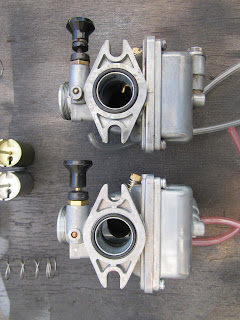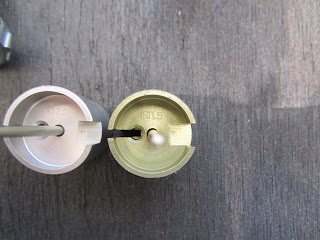 |
| Original Mikuni VM20 carbie and float |
New floats were hard to find and pretty expensive. After some research I decided to buy a brand new Mikuni VM20 Carburettor. With a price tag of 110,- AUD it's pretty cheap.
There are a couple of different VM20 carbs on the market and the one I bought, VM20-273, looks almost the same as the original.
The Mikuni VM20-273 is supplied with the following factory jetting installed:
Pilot jet 22.5 (M28/1001),
Needle 4J13, Needle Jet O-6/N-6 (238/332Series),
Main Jet 180 (4/042), Air Jet 0.5,
Slide Cutaway 2.0 (VM38/24),
Needle valve 1.5
Every engine requires it's own specific carb set up. Besides the engine you also have to take the climate and altitude in account.
The Yamaha LS3 VM20 carb has the following jetting installed:
Pilot jet 25
Needle 4J13 -2 Needle jet O-0/N-6
Main jet 200 (120 for high land)
Slide cutaway 1.5
Needle valve 1.5
 |
| New original Mikuni VM20-273 carburettor |
 |
| Old and new Mikuni VM20 carbie |
 |
| Old and new Mikuni VM20 carburettor |
So the pilot jet, slide cutaway and the main jet are a bit smaller/leaner than original.
 |
| Old and new slide with different Cutaways |
 |
| Original Needle valve - Mikuni VM20 |
Is it a problem?... Well, it depends on the weather and altitude. As I live on sea level altitude is not an issue. But.. the outside temperature can be very high in summer (30-40 0 Celsius) and that will effect the fuel/air ratio of the final mix.
The higher the outside temp the lower the amount of air/oxygen parts per cm3. So the higher the temp the richer the bike will run (less air for the same amount of fuel). Same story for the altitude, the higher you are the lower the amount of air molecules per cm3.
The current carbie set up is perfect for the hotter summer months. In winter I'll probably swap the pilot - and main jet for the original ones still sitting in the old carbie.


Any advice for 6v to 12v conversion? Cheers!
ReplyDelete